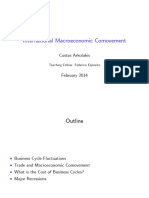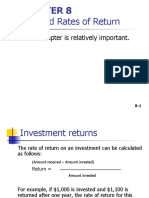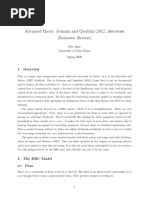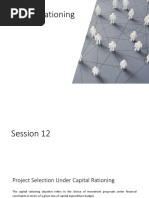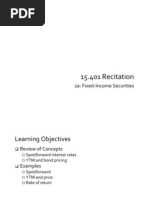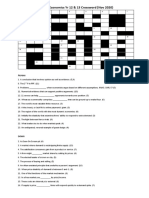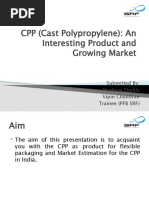Monetary Economics Credit Cycles - The Kiyotaki Moore Model: Nicola Viegi
Monetary Economics Credit Cycles - The Kiyotaki Moore Model: Nicola Viegi
Uploaded by
Brian Magno Ordoñez MangualayaCopyright:
Available Formats
Monetary Economics Credit Cycles - The Kiyotaki Moore Model: Nicola Viegi
Monetary Economics Credit Cycles - The Kiyotaki Moore Model: Nicola Viegi
Uploaded by
Brian Magno Ordoñez MangualayaOriginal Title
Copyright
Available Formats
Share this document
Did you find this document useful?
Is this content inappropriate?
Copyright:
Available Formats
Monetary Economics Credit Cycles - The Kiyotaki Moore Model: Nicola Viegi
Monetary Economics Credit Cycles - The Kiyotaki Moore Model: Nicola Viegi
Uploaded by
Brian Magno Ordoñez MangualayaCopyright:
Available Formats
Monetary Economics
Credit Cycles - The Kiyotaki Moore Model
Nicola Viegi
University of Pretoria
March 2010
Viegi (University of Pretoria) Credit Cycles Lecture 5 March 2010 1 / 15
Introduction
Crisis shows centrality of …nancial market
Objective of this lecture - introduce …nancial intermediaries in a macro
model
The Microeconomics of Banking (to be done in reading groups)
Diamond Dybvig Model - A Model of Bunk Runs
Holstrom and Tirole Model - The Role of the State in Providing
Liquidity
This lecture
Stiglitz and Weiss Model - Imperfect Information and Financial
Transactions
Kiyotaki Moore Model - The Business Cycle E¤ects of Credit Market
Imperfections
Viegi (University of Pretoria) Credit Cycles Lecture 5 March 2010 2 / 15
Credit Market Imperfection - the Stiglitz Weiss Model
Expected Value of Investment Project
pi Ris + (1 pi ) R f = R
Banks lend B = K W and get (1 + r )B in case of success and R f in
case of failure.
Assume that Ris > (1 + r )B > R f for all i.
Asymmetric info: entrepreneur knows his pi the bank does not.
Pro…ts
Firm : E (π i ) = pi [Ris (1 + r )B ]
Z p Z p
Bank : E ( π b ) = (1 + r )B pi g (pi ) dpi + R f (1 pi ) g (pi ) dpi
0 0
Viegi (University of Pretoria) Credit Cycles Lecture 5 March 2010 3 / 15
Credit Market Imperfections
Express the expected payo¤ π i as :
h i
f f
E (π i ) = R R pi (1 + r )B R
which is decreasing in pi :
high risk investors are willing to pay more for a loan, but then dp/dr < 0.
Impact on Banks
Z p
dE (π b )
= B pi g (pi ) dpi +
dr 0
dp h i
+ (1 + r ) Bpg (p ) + R f (1 pi ) g (p )
dr
Optimal Respone of the Bank - Collateral
Viegi (University of Pretoria) Credit Cycles Lecture 5 March 2010 4 / 15
Credit Market Imperfections
Credit Demand
Credit Supply
Interest Rate
Expected Bank Return
Interest rate signal of riskness
Viegi (University of Pretoria) Credit Cycles Lecture 5 March 2010 5 / 15
Credit Market Imperfection and the Business Cycle - the
Kyotaki Moore model
Credit Market Imperfections in a general equilibrium model - Kiyotaki
and Moore
it produces comovement of amount of credit, asset prices and
aggregate output,
it creates a propagation mechanism that produces persistence and
ampli…cation of a shock,
it produces procyclical productivity even if technology does not change,
it is able to explain cross-industry comovements.
Quite Complex - Need di¤erentiated agents
Viegi (University of Pretoria) Credit Cycles Lecture 5 March 2010 6 / 15
Credit Cycles
Viegi (University of Pretoria) Credit Cycles Lecture 5 March 2010 7 / 15
The Model
a constant interest rate (one less variable)
no labor supply decision
no capital accumulation
only one asset that can be used for production, and is available in
…xed supply in the aggregate.
Viegi (University of Pretoria) Credit Cycles Lecture 5 March 2010 8 / 15
The Model
The model includes two kind of agents, productive (farmers) and
unproductive (gatherers). The expected utilities of farmer and gatherers
are respectevely
!
∞
Farmers : E ∑ βs xt +s
s =0
!
∞
Gatherers : E ∑ β0s xt0+s
s =0
where β0 > β .
Viegi (University of Pretoria) Credit Cycles Lecture 5 March 2010 9 / 15
The Model II
The productive agents use a linear production tecnology in capital only as,
yt = (a + c ) kt 1
a fraction ckt 1 of the produced goods is untradable so that the ”farmer”
must consume it on his own.
The productive agent is subjected to a credit constraint like
Rbt = qt +1 kt
Viegi (University of Pretoria) Credit Cycles Lecture 5 March 2010 10 / 15
The Model
basic expression for the ‡ow of funds
qt (kt kt 1 ) + φ (kt λkt 1 ) + Rbt 1 + xt ckt 1 = akt 1 + bt
where φ (kt λkt 1) denotes an input for reproduction of capital.
Viegi (University of Pretoria) Credit Cycles Lecture 5 March 2010 11 / 15
The Model
Only a fraction π of the population can invest while a fraction (1 π )
cannot.
For a farmer, investment is strictly better than consumption, so that it will
use all the funds available to invest, so that xt 1 ckt 1 and Rbt = qt +1 kt
are binding.
Substituting these in the ‡ow of funds and rearranging we have:
qt +1
qt + φ kt = (α + λφ + qt ) kt 1 Rbt 1
R
On the other hand, non productive capital is just depreciating, so that
kt0 = λkt0 1 .
Viegi (University of Pretoria) Credit Cycles Lecture 5 March 2010 12 / 15
The Model
Combining these two law of motion, we get the aggregate capital law of
motion
π
Kt = ( 1 π ) λKt 1 + q t +1 [(α + λφ + qt ) kt 1 Rbt 1]
qt + φ R
(1)
Aggregate debt follows
Bt = RBt + qt (Kt Kt 1 ) + φ (Kt λKt 1 ) aKt 1
1 (2)
Finally, the Euler equation for consumption (a bit atypical), which
determine the asset price
qt +1
u (Kt ) = qt
R
where u (Kt ) is the user cost of capital = G 0 (K Kt ) /R (explained in
the paper). These equations are a …rst-order non-linear system. There is
an unique steady state (q , K , B ) with associated steady state user cost
Viegi (University of Pretoria) Credit Cycles Lecture 5 March 2010 13 / 15
Business Cycle Dynamics
0.3
0.25
B/B*
0.2
K/K*
0.15
0.1 q/q*
0.05
-0.05
0 10 20 30 40 50 60 70 80 90
time
Viegi (University of Pretoria) Credit Cycles Lecture 5 March 2010 14 / 15
Conclusions
Real Business Cycle with large endogenous ‡uctuations
Credit + Imperfect information = …nancial accelarator mechanism
Next - Introducing …nancial frictions in a monetary model with sticky
prices and monopolistic competition
Viegi (University of Pretoria) Credit Cycles Lecture 5 March 2010 15 / 15
You might also like
- Kiyotaki Moore Ers FinalDocument9 pagesKiyotaki Moore Ers FinalJose Luis Herrera HinojosaNo ratings yet
- Agricultural EconomicsDocument60 pagesAgricultural EconomicsOliver TalipNo ratings yet
- Business PlanDocument12 pagesBusiness PlanRyzer Amahit100% (1)
- Ec3115 2020Document8 pagesEc3115 2020dozenNo ratings yet
- The Real Business Cycle Model: Ester FaiaDocument27 pagesThe Real Business Cycle Model: Ester FaiaOtamurodNo ratings yet
- Banking, Liquidity, and Bank Runs in An in Nite Horizon EconomyDocument33 pagesBanking, Liquidity, and Bank Runs in An in Nite Horizon EconomyAlihasen YacobNo ratings yet
- Nath&Stretcher Nov2003Document12 pagesNath&Stretcher Nov2003ritobroto ChatterjeeNo ratings yet
- MCEV Vs IFRSDocument26 pagesMCEV Vs IFRScharlouss100% (2)
- Dynamics ProgrammingDocument34 pagesDynamics ProgrammingMarwaNo ratings yet
- SW Notes Ers FinalDocument48 pagesSW Notes Ers FinalElice YumiNo ratings yet
- Endogenous Growth 2Document93 pagesEndogenous Growth 2marco030901No ratings yet
- Handout 15 DSGE IrisDocument61 pagesHandout 15 DSGE IrisJose LeivaNo ratings yet
- cash in adv slidesDocument39 pagescash in adv slideskarankumar4No ratings yet
- Lecture 9-10 International Business CyclesDocument40 pagesLecture 9-10 International Business Cyclesmarko.drazic2809No ratings yet
- Financial Management: September/December 2017 - Sample QuestionsDocument6 pagesFinancial Management: September/December 2017 - Sample QuestionsVinny Lu VLNo ratings yet
- Notes Consumption Saving 2024Document20 pagesNotes Consumption Saving 2024Rituparna KashyapNo ratings yet
- Topics Intmacro 1Document63 pagesTopics Intmacro 1KadirNo ratings yet
- MJ17 Hybrids F9 Clean ProofDocument6 pagesMJ17 Hybrids F9 Clean ProofVinny Lu VLNo ratings yet
- Investment Accounts-Master Mind Answers PDFDocument7 pagesInvestment Accounts-Master Mind Answers PDFRam IyerNo ratings yet
- Topic 10 Capital BudgetingDocument11 pagesTopic 10 Capital Budgetingsalman hussainNo ratings yet
- EconomicsLecture NotesDocument12 pagesEconomicsLecture NotesYufan WangNo ratings yet
- Advmacro 2014 Falltopic 7 FinalDocument40 pagesAdvmacro 2014 Falltopic 7 FinalAlihasen YacobNo ratings yet
- 2IllustrationsSlides May2021Document63 pages2IllustrationsSlides May2021AgustínNo ratings yet
- Pmak Session2Document31 pagesPmak Session2Sascha Christian SpringNo ratings yet
- CH 08Document13 pagesCH 08junaid1626No ratings yet
- Multi CurvesDocument32 pagesMulti Curvesdeepzc100% (1)
- Kiyotaki and Moore: Handout Class 4Document4 pagesKiyotaki and Moore: Handout Class 4keyyongparkNo ratings yet
- LIBOR and SWAP Market ModelsDocument162 pagesLIBOR and SWAP Market ModelsMario InostrozaNo ratings yet
- A211 April 2021 Examiners ReportDocument12 pagesA211 April 2021 Examiners ReportClerry SamuelNo ratings yet
- Valuation of The China Internet Company Under A Real - 2016 - Perspectives in SDocument9 pagesValuation of The China Internet Company Under A Real - 2016 - Perspectives in SAinie ButtNo ratings yet
- BCQ EARIE PresentationDocument23 pagesBCQ EARIE PresentationRodrigo FernandezNo ratings yet
- Risk and Rates of Return: This Chapter Is Most Important and Will Be Emphasized in TestsDocument66 pagesRisk and Rates of Return: This Chapter Is Most Important and Will Be Emphasized in TestsAhmad Bello DogarawaNo ratings yet
- Externalities, Market Failure and GovernmentDocument6 pagesExternalities, Market Failure and GovernmentMohammad SaifullahNo ratings yet
- Modeling of Banking Profit Via Return-on-Assets and Return-on-EquityDocument6 pagesModeling of Banking Profit Via Return-on-Assets and Return-on-EquitySandi TjokroNo ratings yet
- 07 MultiperiodModel - ADocument63 pages07 MultiperiodModel - Aanto13327000No ratings yet
- Growth Model: Part 1Document14 pagesGrowth Model: Part 1z_k_j_vNo ratings yet
- Screenshot 2024-10-09 at 4.38.05 PMDocument9 pagesScreenshot 2024-10-09 at 4.38.05 PMmonisha.mahajanNo ratings yet
- BF PP 2017Document4 pagesBF PP 2017Revatee HurilNo ratings yet
- Risks and Rate of Return PresentationDocument65 pagesRisks and Rate of Return PresentationMira Monica D. Villacastin100% (1)
- Consumption and Investment SlidesDocument15 pagesConsumption and Investment Slidesresat akanNo ratings yet
- Mantova Conference 2003 - Ivan JohnstoneDocument9 pagesMantova Conference 2003 - Ivan JohnstoneIvanJohnstoneNo ratings yet
- Lecture 1 (Wednesday)Document17 pagesLecture 1 (Wednesday)wajiha.salimyNo ratings yet
- Lecture 3 Perfect Competition and WelfareDocument26 pagesLecture 3 Perfect Competition and Welfareyongjianrong2No ratings yet
- RSM 332 Lecture 2: Tina TanDocument26 pagesRSM 332 Lecture 2: Tina TanBella ChungNo ratings yet
- Ballotta Savelli PresentationDocument21 pagesBallotta Savelli PresentationTroden MukwasiNo ratings yet
- 3 CcapmDocument25 pages3 CcapmsalnasuNo ratings yet
- Macro II Term Paper Jay NoopurDocument15 pagesMacro II Term Paper Jay Noopurrajeshwar panyalaNo ratings yet
- Economics Letters: Eng-Tuck Cheah, John FryDocument5 pagesEconomics Letters: Eng-Tuck Cheah, John FryIsmaîl TemsamaniNo ratings yet
- Jermann Quadrini 2012 Ers Notes FinalDocument17 pagesJermann Quadrini 2012 Ers Notes FinalElice YumiNo ratings yet
- Econ0039 Summer 2024 Final PaperDocument7 pagesEcon0039 Summer 2024 Final PaperShanker VeluNo ratings yet
- Multiplier and IS-LM ModelDocument49 pagesMultiplier and IS-LM ModelPRATIKSHA KARNo ratings yet
- Lecture 10Document40 pagesLecture 10Ronnie KurtzbardNo ratings yet
- Greenwood (LPI Swaps - Pricing and Trading - UkDocument26 pagesGreenwood (LPI Swaps - Pricing and Trading - Ukיובל מרקסNo ratings yet
- Exam 2017Document7 pagesExam 2017Maiken PedersenNo ratings yet
- Examination: Subject CT6 Statistical Methods Core TechnicalDocument13 pagesExamination: Subject CT6 Statistical Methods Core TechnicalPooja SachdevaNo ratings yet
- Topic 1: Balance of Payments: ECON 1270 International Monetary EconomicsDocument55 pagesTopic 1: Balance of Payments: ECON 1270 International Monetary EconomicsLena PhanNo ratings yet
- Chapter 2 - Theory - 6Document32 pagesChapter 2 - Theory - 6Diptish RamtekeNo ratings yet
- American Economic AssociationDocument6 pagesAmerican Economic AssociationScott DoughtyNo ratings yet
- 1StylizedFacts EngDocument29 pages1StylizedFacts EngJUAN BECERRA MENANo ratings yet
- Measuring Pension Fund Performance Using Risk-Adjusted MeasurementsDocument33 pagesMeasuring Pension Fund Performance Using Risk-Adjusted MeasurementssssskkkkllllNo ratings yet
- 15.401 Recitation 15.401 Recitation: 2a: Fixed Income SecuritiesDocument29 pages15.401 Recitation 15.401 Recitation: 2a: Fixed Income SecuritieswelcometoankitNo ratings yet
- Distributed Ledgers: Design and Regulation of Financial Infrastructure and Payment SystemsFrom EverandDistributed Ledgers: Design and Regulation of Financial Infrastructure and Payment SystemsNo ratings yet
- The Institute of Finance ManagementDocument2 pagesThe Institute of Finance ManagementElias DeusNo ratings yet
- Cargo HandlingDocument11 pagesCargo HandlingMuhamad Ibrahim AriefNo ratings yet
- Rate Analysis For Barbed WireDocument1 pageRate Analysis For Barbed WireO Vijay ChandNo ratings yet
- A191 BKAL1013 Tutorial 5 AnswersheetDocument7 pagesA191 BKAL1013 Tutorial 5 AnswersheetMan yeeNo ratings yet
- Edc LW SWS Q.2 RichaDocument58 pagesEdc LW SWS Q.2 RichaAnushree GuptaNo ratings yet
- CamisaDocument16 pagesCamisaFatima Iglesias100% (1)
- Government Companies: 4.1.1 Malabar Cements Limited (Company) Was Incorporated in April 1978Document55 pagesGovernment Companies: 4.1.1 Malabar Cements Limited (Company) Was Incorporated in April 1978spgkumar7733No ratings yet
- RDO No. 22 - Baler, AuroraDocument107 pagesRDO No. 22 - Baler, AuroraRon Catalan100% (2)
- Intraday Momentum The First Half-HourDocument30 pagesIntraday Momentum The First Half-HourRaúl MorenoNo ratings yet
- Unit4_ProblemsetDocument6 pagesUnit4_Problemsetiabhimanyusingh.1No ratings yet
- Paytm StatementDocument3 pagesPaytm Statementayushi tripathiNo ratings yet
- 16th Annual Demographia International Housing Affordability Survey 2020Document16 pages16th Annual Demographia International Housing Affordability Survey 2020jimmywstNo ratings yet
- Effect of Water On Bituminous-Coated Aggregate Using Boiling WaterDocument2 pagesEffect of Water On Bituminous-Coated Aggregate Using Boiling WaterHector PagoadaNo ratings yet
- Marketing Eletronique 15octDocument4 pagesMarketing Eletronique 15octCorina MalaucaNo ratings yet
- MS Word Exams 2023Document7 pagesMS Word Exams 2023Bell InstituteNo ratings yet
- Jis 3131 PDFDocument2 pagesJis 3131 PDFurias90No ratings yet
- Laser SLX1612Document4 pagesLaser SLX1612jfengvedNo ratings yet
- Crossword Micro Yr 12Document2 pagesCrossword Micro Yr 12sarah glassNo ratings yet
- Case Otto ParagamacDocument1 pageCase Otto ParagamacJan Kyle ParagamacNo ratings yet
- 26071-V46A-D-160!01!00012 - 051 - Detail Drawing of Ladder & Platform For Caustic Storage Tank (D-160-01)Document4 pages26071-V46A-D-160!01!00012 - 051 - Detail Drawing of Ladder & Platform For Caustic Storage Tank (D-160-01)Musslih YuliantoNo ratings yet
- Is 18162 2023 Pulses and SoyabeanDocument14 pagesIs 18162 2023 Pulses and SoyabeanKiran DasNo ratings yet
- Invoice 61520945Document1 pageInvoice 61520945nivedNo ratings yet
- 2022 Stat6089 Lgda TP2-W3-S3-R0 2401967132Document5 pages2022 Stat6089 Lgda TP2-W3-S3-R0 2401967132Oki AdityaNo ratings yet
- MMM MMDocument2 pagesMMM MMTanzina IslamNo ratings yet
- Intermediate Accounting Volume III 2012 Edition Suggested AnswersDocument5 pagesIntermediate Accounting Volume III 2012 Edition Suggested AnswersEuphoriaNo ratings yet
- CPP (Cast Polypropylene)Document22 pagesCPP (Cast Polypropylene)donisback2010No ratings yet
- Ho4 Trademark and MastheadDocument1 pageHo4 Trademark and Masthead21100257No ratings yet
- MTMP Preparation Guideline Nepal Municipality3Document2 pagesMTMP Preparation Guideline Nepal Municipality3kishor thapaNo ratings yet













